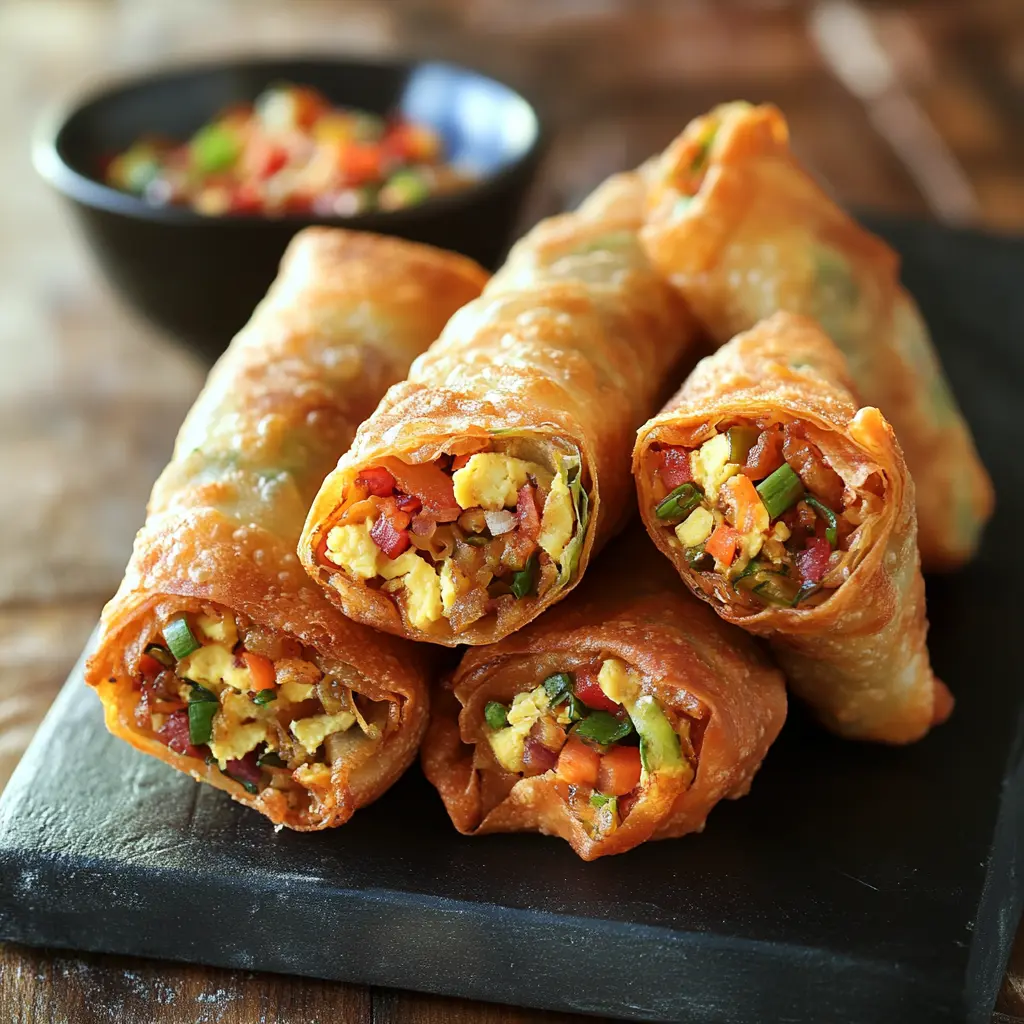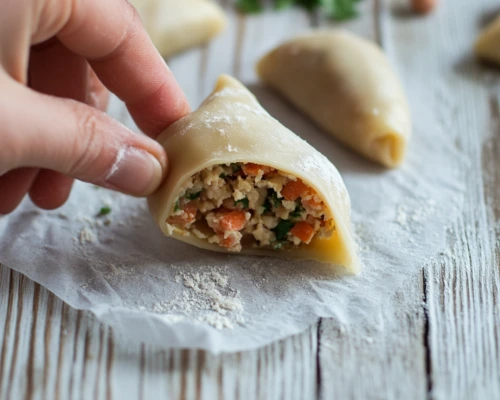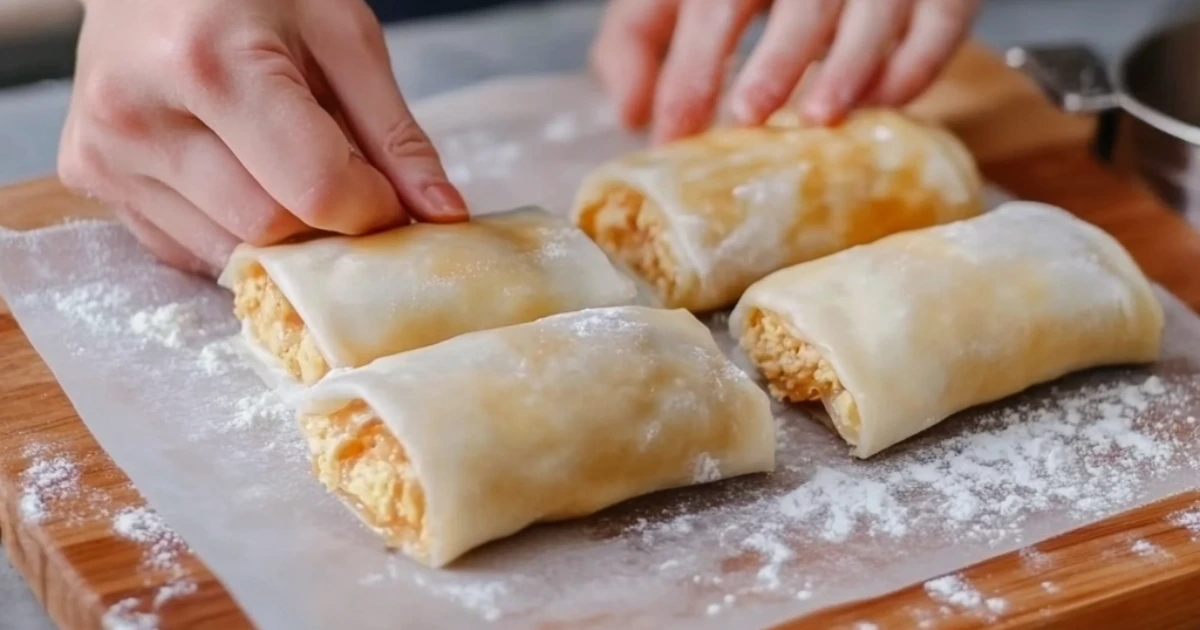Introduction
Egg rolls are a popular appetizer that has become a staple in many kitchens worldwide. Whether you’re enjoying them at a Chinese restaurant or making them at home, these crispy, flavorful treats offer a unique combination of savory fillings wrapped in a delicate, crunchy shell. But how do you fill egg rolls? This process requires a bit of attention to detail and technique to ensure the perfect balance of ingredients and texture. In this guide, we will explore all aspects of egg rolls, from understanding the basic ingredients to the step-by-step process of filling and cooking them.
Table of Contents
Overview of Egg Rolls
Egg rolls are often mistaken for spring rolls, but they differ in both their preparation and flavor. Typically, egg rolls feature a thicker wrapper and are deep-fried to achieve their signature crunch, whereas spring rolls may use thinner wrappers and are sometimes served fresh. While egg rolls originated in China, they have evolved and adapted across cultures, with variations seen in different regions of the world. Their versatility makes them suitable for a wide range of fillings, allowing for endless flavor combinations to suit every palate.
What Are Egg Rolls? Definition, Types of Egg Rolls, and Their Key Ingredients
Egg rolls are a type of fried appetizer or snack that consists of a filling wrapped in a thin, dough-like wrapper. The wrapper is typically made from wheat flour, and the filling can vary greatly, often including a mixture of vegetables, meat, or seafood. The origins of egg rolls trace back to Chinese cuisine, although they have since become a beloved dish in other parts of the world, particularly in American-Chinese food.
For a modern twist on egg rolls, explore Breakfast Egg Rolls and experiment with creative breakfast-inspired fillings.
Types of Egg Rolls:
- Traditional Chinese Egg Rolls: Typically filled with shredded cabbage, pork, shrimp, or a combination of both.
- Vegetarian Egg Rolls: These focus on vegetables like cabbage, carrots, and mushrooms, offering a meat-free option.
- Fusion Egg Rolls: Incorporating non-traditional ingredients like cheese, chicken, or spicy fillings, these egg rolls blend various culinary influences.
Key Ingredients:
- Egg roll wrapper: This is the outer shell, usually made with flour and water.
- Filling: The heart of the egg roll, often a combination of cabbage, carrots, onions, and meat.
- Seasonings: Ingredients like soy sauce, ginger, and garlic are used to add flavor.
Choosing the Right Egg Roll Wrappers
The key to making delicious egg rolls begins with choosing the right wrapper. Egg roll wrappers come in various sizes and textures, so selecting the right one is crucial for achieving the best results.
Factors to Consider:
- Thickness of the wrapper: Thicker wrappers tend to crisp up better when fried, while thinner ones might be more delicate but require extra care when rolling.
- Size of the wrapper: Larger wrappers are ideal for bigger fillings, while smaller ones work better for appetizers or snacks.
- Pre-made vs. homemade wrappers: While pre-made wrappers are convenient and easy to find, making your own can give you more control over texture and flavor.
Preparing the Filling Ingredients. Common Ingredients, Flavor Variations, and Dietary-Specific Options
The filling of an egg roll is where the magic happens, offering a wide range of flavors and textures. Whether you’re making a classic pork and cabbage filling or a more creative version, preparation is key.
Common Egg Roll Ingredients:
- Shredded cabbage: A common base for the filling, it provides crunch and absorbs flavors well.
- Carrots: Shredded or julienned, carrots add a sweet crunch to balance the cabbage.
- Protein: Ground pork, chicken, shrimp, or even tofu for a vegetarian version.
- Seasonings: Ginger, garlic, and soy sauce bring depth to the filling.
Flavor Variations:
- Spicy fillings: Add chili paste or sriracha for a spicy kick.
- Sweet fillings: Consider adding a touch of pineapple or teriyaki sauce for a sweet-savory twist.
Dietary-Specific Options:
- Gluten-free: Look for gluten-free wrappers or substitute with rice paper.
- Vegan: Substitute the meat with plant-based proteins like tofu or tempeh.
How Do You Fill Egg Rolls? Step-by-Step Guide to Filling Egg Rolls with Tips for Achieving Even Distribution
Filling an egg roll requires a careful balance of ingredients. If the filling is unevenly distributed, it can cause the egg roll to be unbalanced or leak when cooking. So, how do you fill egg rolls properly?
- Prepare the Filling: Start by cooking the filling ingredients (e.g., meat, vegetables) in a pan, seasoning them to taste. Once cooked, allow the mixture to cool before proceeding.
- Portion the Filling: Take about 2 tablespoons of filling and place it near the edge of the wrapper. Don’t overfill, as this can lead to breakage or difficulty in rolling.
- Distribute Evenly: Gently spread the filling into a line, leaving some space at the edges of the wrapper to avoid leakage.
- Fold the Edges: Fold in the sides of the wrapper, ensuring the filling is contained securely.
- Roll the Egg Roll: Starting from the edge with the filling, tightly roll the wrapper while ensuring the filling stays in place. Seal the edge with a little bit of water or egg wash.
By following these steps, you’ll ensure that your egg rolls are perfectly filled and secure for frying or baking.
Rolling Techniques for Perfect fill egg rolls. How to Wrap and Roll Egg Rolls Securely to Prevent Breakage or Leaking

The technique of rolling your egg rolls is crucial to achieving a crisp, well-sealed exterior that doesn’t break open during cooking. Whether you’re a beginner or an experienced chef, getting the rolling process right is essential.
Key Rolling Tips:
- Use a clean surface: Lay the wrapper flat on a clean, dry surface to ensure the filling sticks properly.
- Tuck tightly: As you roll, gently press the filling down and tuck the sides in. This helps create a compact roll that will hold up during frying.
- Seal the edges: Wet the edges of the wrapper to help it stick. This ensures the roll stays tightly sealed while cooking.
- Don’t overfill: If you overstuff the egg rolls, they can break open or leak during cooking. Keep the filling portion moderate for the best result.
Additional Rolling Methods:
- Diagonal rolling: For a more triangular shape, roll the wrapper diagonally for a unique presentation.
- Double wrapper: For extra crispiness and durability, try using two wrappers for one egg roll.
Cooking Methods for fill egg rolls. Comparison of Frying, Baking, and Air-Frying Egg Rolls
The cooking method you choose will greatly affect the texture and flavor of your egg rolls. Each method offers unique benefits depending on the results you’re aiming for.
1. Frying:
- Crispy texture: Frying produces the crispiest egg rolls with a golden-brown exterior.
- Quick cooking time: Egg rolls cook in a matter of minutes when deep-fried.
- Best for traditional egg rolls: If you want the classic texture, deep frying is your best bet.
Steps:
- Heat oil to 350°F (175°C).
- Fry egg rolls in batches for about 3-4 minutes until golden brown.
- Drain on paper towels to remove excess oil.
2. Baking:
- Healthier alternative: Baking requires less oil, resulting in a less greasy product.
- Even cooking: The heat from the oven ensures a uniform crispness across the egg roll.
Steps:
- Preheat the oven to 400°F (200°C).
- Place egg rolls on a baking sheet and lightly spray with cooking oil.
- Bake for 15-20 minutes, flipping halfway through to ensure even cooking.
3. Air-Frying:
- Less oil, same crispiness: The air fryer offers a healthier version of fried egg rolls while still giving a crispy finish.
- Quick and convenient: Air frying cuts down on cooking time and oil consumption.
Steps:
- Preheat the air fryer to 375°F (190°C).
- Lightly spray egg rolls with oil and place them in the air fryer basket.
- Cook for 8-10 minutes, turning once for even crispiness.
Tips for Ensuring Crispiness: Techniques to Achieve Golden, Crispy Egg Rolls
Crispiness is one of the most important features of a great egg roll. To achieve the perfect golden-brown exterior, there are a few key techniques to keep in mind.

1. Use the Right Wrapper
- Thin, high-quality egg roll wrappers crisp up better than thick, low-quality ones.
- For extra crunch, consider using a double layer of wrappers.
2. Preheat the Oil
- If frying, ensure the oil is preheated to 350°F (175°C). Oil that’s too cold will result in soggy egg rolls.
- If using an air fryer or oven, preheat to the recommended temperature for even cooking.
3. Avoid Overcrowding
- Whether frying or baking, avoid overcrowding the egg rolls in the pan or fryer. This allows air circulation, ensuring they crisp up properly.
4. Use Minimal Moisture
- Excess moisture in the filling can make the wrappers soggy. Be sure to drain ingredients like cooked vegetables before wrapping.
By following these tips, you’ll ensure your egg rolls are perfectly crispy every time.
Filling Ideas for Egg Rolls: Creative Filling Options Including Vegetarian, Vegan, and Dessert-Inspired Ideas
Filling an egg roll offers endless possibilities for creativity. Whether you prefer savory or sweet, there are numerous combinations that can elevate your egg rolls. If you’re wondering how do you fill egg rolls?, consider some of these filling ideas.
1. Vegetarian Options
- Vegetable Medley: A mix of shredded cabbage, carrots, and mushrooms.
- Spinach and Cheese: A blend of spinach, feta cheese, and herbs for a savory treat.
2. Vegan Options
- Tofu and Veggies: Tofu combined with cabbage, carrots, and soy sauce.
- Sweet Potato and Black Beans: A nutritious and hearty option with sweet potatoes and black beans.
3. Dessert-Inspired Egg Rolls
- Chocolate and Banana: Chocolate chips and banana slices make for a sweet and indulgent filling.
- Apple Cinnamon: Apples and cinnamon create a warm, comforting dessert egg roll.
These unique fillings will add variety to your egg rolls and give you endless ways to experiment.
Common Mistakes and How to Avoid Them: Troubleshooting Common Issues Like Overfilling, Soggy Wrappers, or Uneven Cooking
Making egg rolls can be tricky if you’re unfamiliar with the process. Below are some common mistakes and how to avoid them:
1. Overfilling the Egg Rolls
- Overfilling can cause the egg rolls to break or leak during cooking. Be sure to use a moderate amount of filling to avoid this.
2. Soggy Wrappers
- If the filling is too wet, it can make the wrappers soggy. Make sure to cook vegetables and meats properly, draining excess moisture.
3. Uneven Cooking
- Overcrowding the pan or fryer can lead to uneven cooking. Ensure the egg rolls have enough space to cook evenly on all sides.
By avoiding these common pitfalls, you’ll ensure your egg rolls turn out perfect every time.
Serving Suggestions and Sauces: Ideas for Serving Egg Rolls with Complementary Sauces and Garnishes
Egg rolls are delicious on their own, but adding a dipping sauce can elevate the experience. Here are some ideas for serving your egg rolls:
1. Classic Dipping Sauces
- Sweet and sour sauce: The tangy flavor complements the crispy texture of the egg roll.
- Soy sauce: A simple, salty sauce works well for savory egg rolls.
2. Spicy Options
- Sriracha mayo: A creamy and spicy dip adds a kick to your egg rolls.
- Chili oil: For those who prefer heat, chili oil is a flavorful choice.
3. Garnishes
- Consider garnishing with finely chopped green onions, cilantro, or sesame seeds to enhance the flavor and presentation of your egg rolls.
These sauces and garnishes add an extra layer of flavor that pairs beautifully with the crispy egg rolls.
Can You Make Egg Rolls Ahead of Time? Storage Tips, Freezing Methods, and Reheating Techniques
Egg rolls are a great make-ahead snack, and knowing how to store and reheat them properly ensures they maintain their crispy texture.
1. Storage Tips
- If you plan to store egg rolls, place them on a baking sheet and cover them loosely with plastic wrap. Refrigerate for up to 2 days.
2. Freezing Methods
- To freeze egg rolls, arrange them on a tray in a single layer. Once frozen, transfer them to an airtight container or zip-top bag for long-term storage.
3. Reheating Techniques
- To reheat frozen or leftover egg rolls, bake them at 375°F (190°C) for 10-15 minutes. Alternatively, air fry at 350°F (175°C) for 5-7 minutes to restore their crispiness.
By following these storage and reheating methods, you can enjoy your egg rolls anytime without losing their texture.
Healthier Alternatives to Traditional Egg Rolls: Using Gluten-Free Wrappers, Low-Fat Fillings, and Alternative Cooking Methods
If you’re looking to enjoy egg rolls without the added calories and fat, there are several healthier alternatives to consider.
1. Gluten-Free Wrappers
- You can find gluten-free egg roll wrappers at most health food stores or use rice paper for a lighter, gluten-free option.
2. Low-Fat Fillings
- Opt for lean proteins like chicken breast or tofu instead of fatty meats like pork.
- Load up on vegetables like spinach, zucchini, and bell peppers to add volume without the extra calories.
3. Alternative Cooking Methods
- Consider using an air fryer or baking instead of deep-frying to reduce the amount of oil and make your egg rolls healthier.
These alternatives allow you to enjoy the delicious taste of egg rolls without sacrificing your health goals.
FAQs: About How Do You Fill Egg Rolls?
Here are some common questions about egg rolls and their preparation.
1. How do you fill egg rolls properly?
- The key to filling egg rolls is to avoid overstuffing. Use about 2 tablespoons of filling and ensure it is evenly distributed. Fold the edges of the wrapper and tightly roll it to secure the filling.
2. What is the best method for cooking egg rolls?
- Deep-frying is the most traditional method for achieving crispy egg rolls, but baking or air frying are healthier alternatives that still produce a crispy texture.
3. Can egg rolls be made ahead of time?
- Yes, egg rolls can be made ahead of time and stored in the fridge or freezer. Just reheat them in the oven or air fryer to restore their crispiness.
By addressing these common questions, you’ll be able to tackle egg roll preparation with confidence.
Conclusion : How Do You Fill Egg Rolls?
Egg rolls are a versatile and delicious dish that can be customized to suit any taste. From creative filling ideas to exploring healthier alternatives, there are endless ways to make egg rolls your own. Whether you’re wondering how do you fill egg rolls? or seeking tips for achieving the perfect crispiness, following the advice outlined in this guide will ensure your egg rolls turn out perfectly every time.

